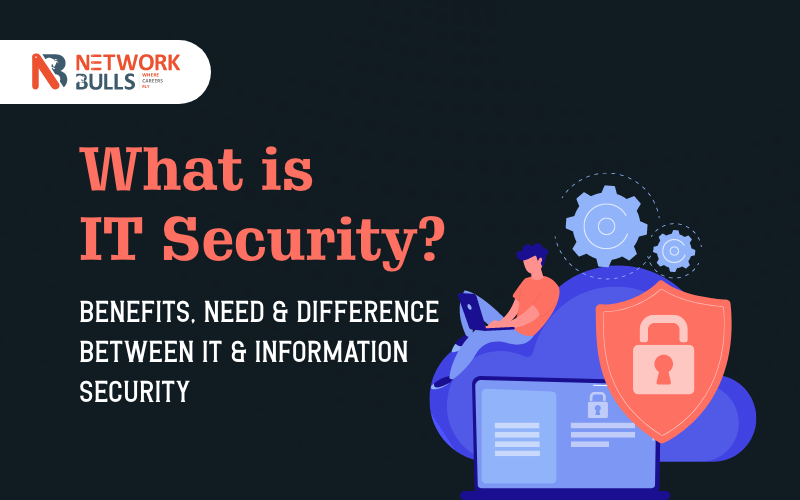What is IT Security? | Benefits, Need & Difference between IT and Information Security

Aimed at protecting computers, digital systems, and networks from intrusions and all other forms of cyber-attacks, IT security denotes a well-laid-out strategy to forestall attempts made by a third party to steal data, insert viruses, and spam to disable your computer system and network.
The primary function of cybersecurity is to guard all sensitive information, help you maintain confidentiality, and block hacking attempts by hackers who use the latest and sophisticated methods to steal your corporate information and disrupt your network.
According to a report published by McKinsey & Company, at the current rate of growth, damage from cyberattacks will amount to about $10.5 trillion annually by 2025—a 300% increase from 2015 levels. In the face of this cyber onslaught, organizations around the world spent around $150 billion in 2021 on cybersecurity, growing by 12.4% annually.
What Is IT Security?
If you are confronted with this question, you have to understand the three fundamental principles of it. They are:
i. Confidentiality: guarding your corporate information.
ii. Integrity: connection of your network and other related technical integrals.
iii. Availability: continuity of your network connection without any disruption.
Need for IT Security
To run your company, corporation, or organization, you need to secure the network fully so that no intrusion can take place and no stealing of information occurs. The need for IT security arises out of the following five reasons.
i. Stop Network Hacking: Drawing a strategy to secure your network is extremely important as hackers or cybercriminals are always active. They apply newer digital methods to steal your company’s information. Due to this, your company needs IT security management.
ii. Quick Response: If you have introduced a sophisticated IT security regime, you would come to know the moment an attempt has been made to breach your network. You can respond quickly to control the damage already being done to your network.
iii. Perennial Security: The need for IT security arises out of the reason for keeping your network under constant watch in an automated way. Even minor laxity may cause cyber hackers to enter your networking system to steal the information.
iv. Safeguarding Corporate Secrecy: Your business model is your closely guarded secret. Nobody else should know it. If they breach your secret information system, they may inflict a major business blow to you. The need for IT security comes to the fore in this regard.
v. Ensuring Uninterrupted Network Function: All corporate companies are afraid of disruption in their networking, whether LAN or WAN (or both). Your network can function in an uninterrupted way if you can stop any intrusion into the system. This can be ensured by introducing IT cybersecurity.
Difference between IT Security and Information Security
It is important for you to know the difference between IT security and information security.
You can understand the differences between the two in the following way:
IT Security
This basically means protecting your corporate data.
Securing digital data by implementing computer network security.
Foiling digitally all attempts to disrupt your network.
Information Security
Initiating processes to protect classified company information.
Using specific and designated tools to safeguard sensitive business information from intrusion and invasion.
Overall, it means protecting all information of your company.
Types of IT Security
You can implement different types of IT security in your company or organization. They are:
i. Network Security: It is mostly implemented to stop any intrusion into your digital system and network. If you implement it, a hacker may not be able to access data inside your network.
ii. Internet Security: Internet security must be applied to safeguard communication: information sent and information received in browsers. Firewalls, antimalware, and antispyware can provide this security to your browser.
iii. Endpoint Security: You need this to protect your computer (PC or laptop), tablet, cell phone, or at the device level. Your device cannot be accessed by cyber hackers or malware inserted into your network.
iv. Cloud Security: This security step is very useful as you, as a user, are connected directly to the Internet as the applications, data, and identities are moving to the cloud.
v. Application Security: Your vulnerability to intrusion is secured as special codes are used for the application at the time of their creation.
Benefits from IT Security
Your computer and computer network can gain much by implementing IT security. Your corporate company can reap the following benefits from IT security:
i. Prevention of all network threats
ii. Prevention of security breaches or data theft
iii. Prevention of unauthorized access as IT security will forestall any attempt to intrude into your network
iv. Fully secured data management
v. Uninterrupted functioning of your network.
Conclusion
Cybercriminals use ultra-sophisticated digital methods to steal your data and penetrate your network. A big business organization deploys its IT assets in large places, offices, production facilities, and sales centers. As a result, a rival company may prize such data or information like new clients, a list of clients with whom the company is negotiating, costing of products and services, and their market pricing. Such a company may be negotiating with some other company for technology transfer. These are things of immense importance for the rival company. As a result, such a company may try to penetrate your company’s network to steal the data. The only way to stop it is to introduce a foolproof IT security regime into your company’s digital system.
FAQs (Frequently Asked Questions)
i. What are the differences between IT security & Information Security?
IT security involves protecting corporate data and information, ensuring the safety of information. Information security implements various digital technologies to protect networks, the internet, and endpoint security.
ii. What are the different types of IT security?
IT security aims to shield computers, digital assets, data, and networks from third-party intrusion, implementing digital measures to prevent intrusion and virus injection.
iii. What is Information security?
Information security comprises digital methods and scientific rules to protect corporate information and business secrets, configuring systems to prevent unauthorized intrusion.
iv. Why must you implement IT security & Information Security in your network?
Implementing both is necessary to secure network systems, hardware, software, protect against intrusion, and prevent data theft.
v. What is the need for implementing IT security & Information Security in your network?
For businesses, implementing both IT security and Information security is crucial to safeguard business secrets and information from rivals seeking to damage the business.
- RECOMMENDED POSTS
-
Trending (0)

-
Network Bulls Placements (53)

-
CCIE (101)

-
CCNP (32)

-
CCNA (40)

-
Awards (14)

-
Network Bulls Reviews (53)

-
Informational Articles (74)

-
Technical Articles (26)

-
CCIE Success Stories (40)

-
Summer Training Courses (5)

-
CCIE Security Version 5 (34)

-
CCIE Data Center (19)

-
MCSE (3)

-
Industrial Training (10)

-
Microsoft Certification (3)

-
Ask NB (7)

-
Network Bulls Offers (6)

-
Best Institute for CCIE Training in India (118)

-
CCIE Training Courses (78)

-
DHCP (2)

-
Webinars (6)

-
Training (127)





















